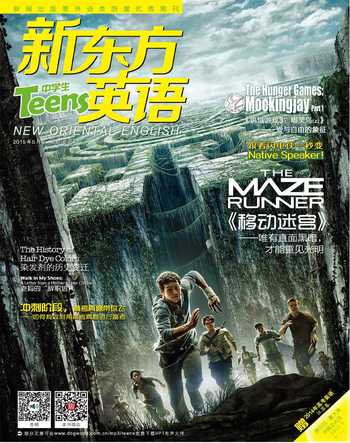人人都期待的四大未来发明
阿琼
In this article we'll look at four future inventions we've been waiting for all our lives. Which ones are just around the corner, and which ones are mere fantasies?
无人驾驶汽车
We humans are often the most dangerous part of an automobile. That's why scientists have been working on automated highway technology for decades. In the 1990s, the U.S. Department of Transportation sponsored the National Automated Highway System Consortium (NAHSC), which successfully demonstrated the potential of radar, magnetic1) and visual sensors that allowed test vehicles to navigate2) a specially prepared length of highway. The U.S. Defense Advanced Research Projects Agency (DARPA) also underwrote3) an autonomous vehicle research and development program, culminating in4) its 2007 Urban Challenge5).
But this is one future invention that we're probably going to see sooner rather than later. Since 2007, Google scientists and engineers have been working to develop autonomous vehicles that use artificial intelligence software and Google Maps to navigate. Testing of driverless cars on public roads actually has been approved in Nevada, Florida and California. In fact, Google says that about a dozen self-driving cars are on the road at any given time, and they've travelled 500,000 miles (804,672 kilometers) in beta tests6).
Google still awaits federal and state regulatory approval to engage in more extensive tests, and it's still unclear when—or rather, if—ordinary folks will be able to buy a car that drives itself. But there's talk that Google is set to build its own driverless car. Electric car company Tesla is also throwing its driving cap into the race, claiming it can have a car that does 90 percent of the work by 2016.
我们人类通常是一辆汽车中最危险的因素,所以科学家们才会数十年来一直致力于研究自动高速公路技术。在20世纪90年代,美国交通部向国家自动高速公路系统协会提供了资助,后者成功地展现了雷达、磁力传感器和视觉传感器的潜力,这些仪器辅助许多受测车辆通过了一段经过特别安排的公路。美国国防部高级研究计划署也资助了一个自动车辆的研发项目,并最终在2007年举办了无人驾驶汽车城市挑战赛。
不过这一未来发明我们可能不久就会看到其成为现实。自2007年以来,谷歌的科学家和工程师就一直致力于开发由人工智能软件和谷歌地图导航的自动车辆。内华达州、佛罗里达州和加利福尼亚州也早已准许无人驾驶汽车上公路进行实测。事实上,谷歌公司称,在任意指定的时段里大约有12辆自动驾驶汽车在公路上行驶,在β测试中它们已行驶了50万英里(804,672公里)。
谷歌还在等待联邦和州的审批,以便进行更广泛的测试,但是什么时候——或者更确切地说,是否有那么一天——普通人能够购买一辆可以自动驾驶的汽车还是个未知数。不过,据说谷歌将要开发自己的无人驾驶汽车。电动汽车制造公司特斯拉也决心投入这场竞赛中,声称其可以在2016年之前制造出一辆90%自动驾驶的汽车。
水下城市
The ocean presented early humans with a vast mystery. What worlds and fabulous7) creatures exist in the deep? Today, our understanding has expanded, but the world's waters still offer us an abundance of mystery and awe8). We dream less about mermaid cities and sunken Atlantis and instead imagine underwater metropolises and seafloor colonies.
This zeal9) was especially strong in the late 1950s and early 1960s, when Jacques Cousteau's Conshelf project10) and the United States Navy's Sealab saw the dream of undersea living realized. Both programs proved that humans can live and work for an extended time underwater. The test subjects11) tended12) underwater gardens, tackled13) underwater construction projects and lived the life of an aquanaut14).
Half a century later, the underwater cities still aren't here. Sure, we have unrealized designs such as Giancarlo Zema's semisubmerged Trilobis 65 dwelling and the proposed underwater Dubai Hydropolis, but very few underwater habitats. The bottom line15) is that while humans can live underwater, it's not an easy or cheap life. It's also not necessary.
对于早期人类来说,海洋是一个巨大的谜团。在深海之下存在着什么样的世界和神奇的生物呢?今天,我们的认识已经有所拓展,但是这个世界的水域还是让我们觉得无比神奇,让我们充满敬畏。我们不再总是遐想着美人鱼的城市和沉没的亚特兰蒂斯城,而是开始想象水下的都市和海底殖民地。
这种对海洋世界的热情在20世纪50年代末到60年代初的时候尤其强烈,当时雅克·库斯托的“大陆架计划”和美国海军的海洋实验室都见证了海底生活之梦的实现。两个项目都证明了人类可以长时间在水下生活和工作。那些实验对象打理水下花园,着手水下建设工程,过着海底实验室工作人员的生活。
半个世纪过去了,水下城市仍未建成。当然,我们有些尚未实现的设计,如贾恩卡洛·泽马(编注:意大利著名设计师)的半潜式居住游艇“Trilobis 65”,还有尚在计划中的迪拜水下酒店Hydropolis,但很少有水下居住地。最重要的是,虽然人类可以在水下生活,但这样的生活既费力也不划算,而且也没必要。
机器人女佣
The most obvious answer to a complaint about the lack of robot maids is of course, "Hey, buddy, go buy a Roomba16)." Because while they don't really resemble George Jetson's robotic maid Rosie, modern bots do carry out a host of floor vacuuming17), tile18) scrubbing and pool cleaning chores.
Of course, the vision of the computerized maid goes beyond mere automated dust busting19). What we've been waiting for is a true robotic domestic servant capable of safely navigating a human living environment to carry out everything from cleaning the toilet to cooking pancakes.
But in order to actually move through our kitchens and interact with us, robots will need to be capable of social learning. A truly social bot will need to evaluate environmental stimuli20) with a discriminating eye. In short, a true robotic maid would need to be autonomous. Scientists from Cornell University are on the case, and are slowly creating robots that might be able to anticipate human needs. They predict that in the next few years we might see a robot maid who can do some specific tasks. So far, they've already developed a robo-maid who can open a fridge and pour you a beer. A far greater help than, say, folding laundry.
面对没有机器人女佣的抱怨,最没有新意的回应自然是:“嘿,伙计,去买个Roomba清洁机器人就行了。”因为虽然清洁机器人并不像乔治·杰森(编注:美国动画片《杰森一家》中的人物)的机器人女佣罗西那样,但现代机器人确实能完成一大堆诸如清扫地板、擦洗瓷砖以及清洁泳池这类的杂务。
当然,我们想象中的计算机化的女佣能做的可不止自动除尘。我们一直期待的是一个能够安全穿梭于人类生活环境、包揽从打扫卫生间到做薄煎饼等所有家务的真正的家用机器佣人。
但是机器人若想能真正做到在厨房里自由行动并与我们互动,就需要具备社会学习的能力。一个真正的社交型机器人需要用有辨识力的眼睛去评估外界的刺激。简单地说,一个真正的机器人女佣得是自主独立的。康奈尔大学的科学家们在进行这方面的研究,他们正在慢慢开发可能会预判人类需求的机器人。他们预测在接下来的几年里,我们可能就会看到一个能够完成某些特定任务的机器人女佣。到目前为止,他们已经开发出了能够打开冰箱门和给你倒杯啤酒的机器人女佣。这可比叠衣服之类的有用多了。
药片食物
Since the 1800s, futurists have been dreaming about creating miniaturized, 100-percent synthetic21) food from chemicals, so it could be consumed in tablet or capsule22) form. Some envisioned23) it as a way to free homemakers from the drudgery24) of cooking or spare animals from slaughter, while others saw it as a way to feed the planet's growing population without overtaxing farm soil or other natural resources. A 1936 Popular Science Monthly article predicted that "modern alchemists25)" in food laboratories eventually would create food pills that would contain everything necessary for life—a feat that would render26) man forever independent of natural resources for his nourishment, and banish fear of crop failure and famine.
It's an idea that has persisted over the years in science-fiction fantasies. The problem is that unless someone figures out a way to alter the laws of physics, getting your daily nutrition from a capsule or tablet is pretty much impossible. Think of it this way: the typical human needs to ingest27) about 2,000 calories each day, and a gram28) of fat—the most efficient way to provide them—contains about nine calories. Thus, to meet your daily caloric requirement, you'd have to ingest 450 or so standard-sized capsules of fat, which would weigh roughly half a pound. And you still wouldn't be getting all the other nutrients—protein, carbohydrates, vitamins, minerals, fiber—that you need to be healthy. Besides, eating nothing but a pill for breakfast, lunch and dinner wouldn't exactly be living large. People like to eat because food tastes good. Pills generally don't.
自19世纪以来,未来主义者就一直梦想着从化学品中提取制造出微型的百分百合成食物,这样食物就可以做成药片或是胶囊的样子供人食用。有人曾设想这种方法能使家庭主妇从做饭的苦差事中解脱出来,或能使动物免遭杀戮,也有人曾认为这种方法可使人类无须过度使用土地或其他自然资源就能养活这个星球上不断增长的人口。《大众科学月刊》1936年刊载的一篇文章预言食品实验室里的“现代炼金术师”最终会发明出一种含有生命所需一切物质的药片食物——一项将使人类永远无须再依靠自然资源来获取营养、无须再担忧谷物歉收或饥荒的壮举。
这样的想法多年来一直存在于科幻小说的各种幻想里。问题是除非有人能想出办法改变物理定律,否则从一个胶囊或药片里获取一整天所需的营养几乎是不可能的。这样试想一下,通常来说一个人每天大约需要摄入2000卡路里热量,而脂肪作为提供热量最有效的方法,每克约含热量9卡路里。所以,为了满足日常所需热量,你得摄入450个左右的这种标准大小的脂肪胶囊,重量大约有半磅(编注:约0.227公斤)。但即使这样你也还是没能摄入维持健康所需的其他营养物质:蛋白质、碳水化合物、维生素、矿物质、纤维素。此外,一日三餐都只吃药片实在不能算是奢侈的生活。人们喜欢吃是因为食物美味,但药片通常吃起来都不怎么样。

